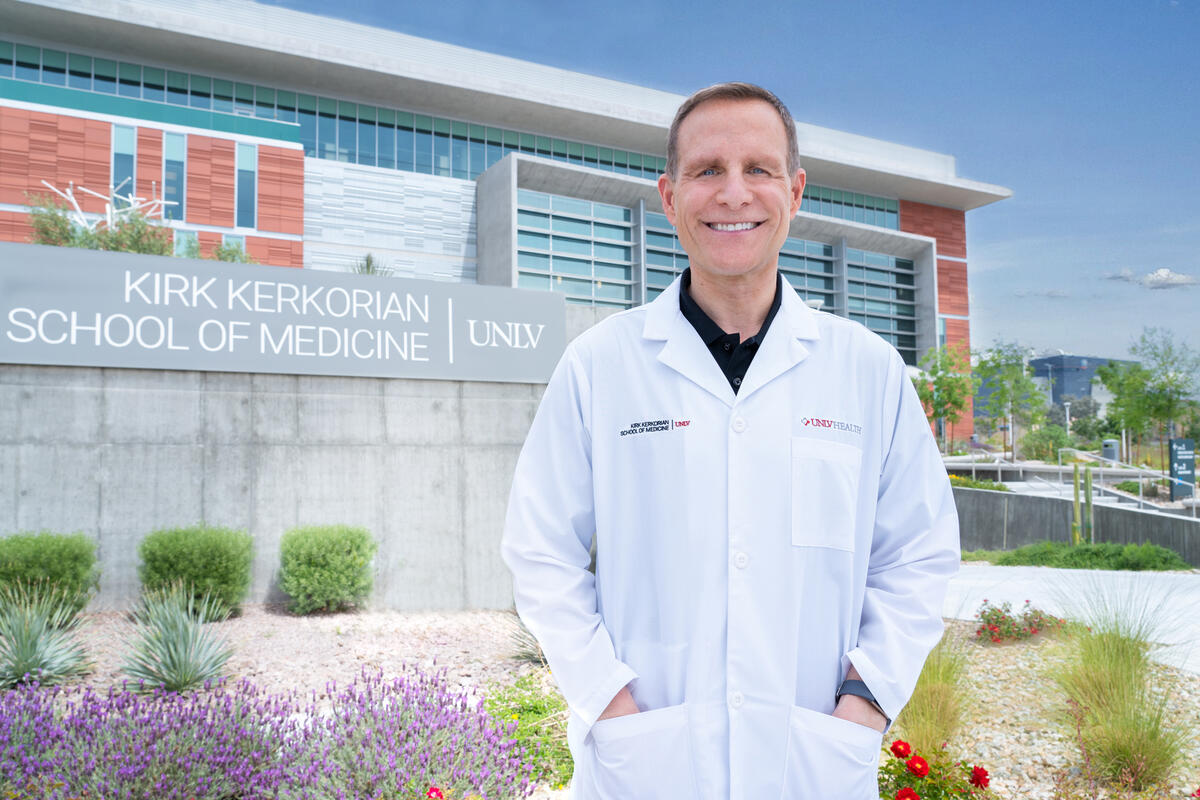If you’ve seen the Michael J. Fox movie, Doc Hollywood, or were a fan of the `90s hit TV series, Northern Exposure, you get a tiny glimpse into the world of rural family medicine, albeit highly fictionalized. Especially the part where the unsuspecting doctor becomes profoundly and emotionally attached to the small town where he is practicing.
Dr. Aron Rogers, associate professor, rural family medicine program director, and family medicine clerkship director at the Kirk Kerkorian School of Medicine at UNLV, describes how that process of attachment can work.
“‘What am I doing here? Doing family medicine, rural medicine,’” he says, mimicking what he believes are the initial thoughts of a new resident when they arrive in the town of Winnemucca, Nevada. “And then I watch them go through their internship here. And the most important piece is watching the change that happens from the time they go up to Winnemucca … All the experiences they've had, the relationships they've had with the town —they really become deeply rooted in that community. It isn't just coming up and being a part of the residency. You're a part of the town.”
Dr. Michael Rees, chief resident of the Department of Family and Community Medicine, who’s graduating in June, concurs.
“One of the more rewarding things about doing family medicine in a rural setting,” Rees says, "is that it’s a small enough town that your impact is felt on an individual basis.”
The origins of the program go all the way back to 2010, when the traditional family medicine program started a rural family medicine residency program in the Northern Nevada town of Winnemucca.
Nevada is ranked 48th in the nation for active primary care physicians per 100,000 population, according to the Physician Workforce in Nevada 2022 Annual Publication. The need for healthcare in this particular region is stark, as it is considered to be a 10,000-square-mile catchment area, otherwise known as a service area.
Rogers, who was director of the traditional program at the time, said they were welcomed with open arms by residents in the town of 8,000.
“And since I was the director of the traditional program at the time, it just seemed like a natural transition for me to take over the rural program,” says Rogers. “I think the original thought was maybe that would be temporary.”
That thought, nearly 15 years later, provides a wry chuckle.
In 2013, the program became accredited and, in 2014, it opened to residents. Residents see patients through Humboldt General Hospital under the direction of an attending physician.
One trait that many rural family medicine students, residents, and even faculty like Rogers seem to have in common: They come from small towns or communities. Rogers notes that his own interest in rural family medicine started when he grew up in rural Washington and, at the age of 6, experienced his mother going through labor when they were 40 minutes away from the nearest hospital.
“That's where the seeds were planted,” he says. “Having lived in a rural town and knowing the need that these rural places have for all kinds of medical care.”
Rees also comes from a similar rural setting. “I'm from a really small town in Wyoming. There's about 400-ish people in my hometown.”
He admits one of the things that got him interested in family medicine was watching his hometown doctor and what a pillar of the community he was. When that doctor passed away at a relatively young age in an accident, Rees remembers how that the loss sent shock waves through the community and left him with the belief that “the good you do in family medicine impacts a higher percentage of people in a smaller town.”
Dr. John Brackett, a new graduate of the Kirk Kerkorian School of Medicine, is just now entering the rural family medicine program. He, too, hails from a rural location. “I grew up in a small town in northern Wisconsin with a population of around 1,500 people and scarce resources, including primary care,” Brackett says.
While coming from a rural background seems to be a consistent trait, Rogers says what they’re actually looking for in a rural family medicine resident is something not found on a C.V.
“We're looking at students that aren't just interested in family medicine. As a rural residency can be an even harder ‘sell,’ we're looking for the few, future resident applications that express traits suggestive of a passion for rural medicine. Maybe they come from a rural location, have done rotations in rural areas or, and most importantly, say they want to practice in a rural area.”
Beyond that passion, rural residents are generally interested in "full-scope" medicine, not necessarily specializing, but participating in the overall practice of medicine. They want to train in and have the option to do obstetrics, to assist on surgeries in a rural emergency room, the whole gamut of patient illnesses and experiences. Where there’s no team of specialists for support. The resident is, for the most part, on their own.
“It's just you,” says Rogers. “So when you're on that rotation, it's a one-on-one with you and the attending physician. Whenever it comes to the door, when you're on emergency medicine or when you're on surgery or an inpatient, you're seeing it. You're taking care of that patient.”
Brackett notes that is exactly why he applied to the rural family medicine program. “The training and skills in a rural setting are what drew me in. The rural family medicine program is unique in that it provides the training for people who want to become truly full-scope practitioners. Residents who complete this program are competent and confident in skills not commonly emphasized at most family medicine residencies and are well prepared to practice anywhere they choose.”
After being accredited for 10 years, the rural family medicine program achieved its original goal: to become the main provider of primary care in Winnemucca.
“There were about four or five family docs, primary care docs up there, who did the deliveries and hospital stays …” says Rogers. “And over the years, as they've all gone away, the main providers of primary care, both inpatient and outpatient, are our residents. So, we have become reliant on this town for the training and the goodwill and all that they do for us, but they're also reliant on us.”
In the end, that passion that Rogers looks for takes hold and each resident truly becomes a "Doc Winnemucca" in their own way. He describes how the graduations are full of tears and hugs from Winnemucca residents. “They're really sorry to see them go because they're part of their town family, if you will. They watch them progress in their skill, watching them become part of the town. Watching them really transition into rural physicians is the most rewarding thing.”



